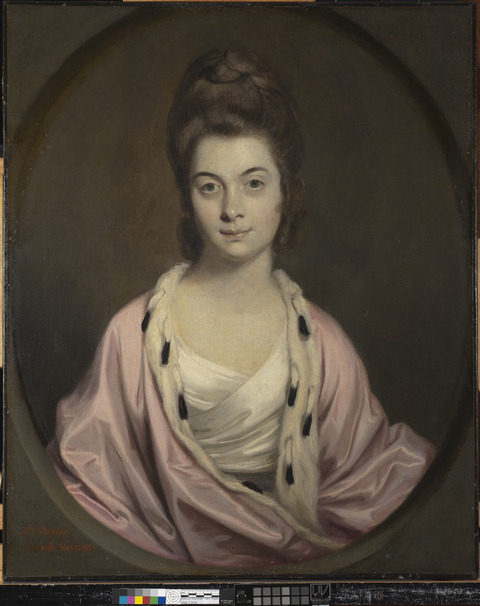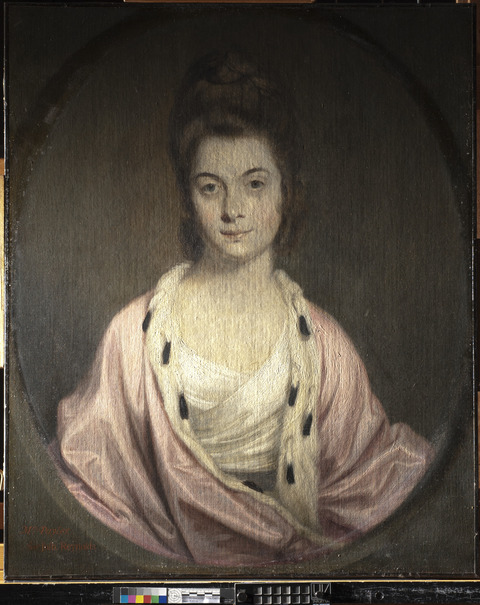Overview
Accession number: 2015.29
Artist: Joshua Reynolds
Title: Portrait of Mrs. Thomas Watkinson Payler
Materials: Oil (untested) on canvas
Date of creation: 1771
Previous number/accession number: C10065
Dimensions:
76.5 cm × 63 cm
Conservator/examiner: Fiona Beckett and Roxane Sperber
Examination completed: 2016, revised 2018
Distinguishing Marks
Front:
Item 1. Signature and title in painted red lettering, bottom-left of painting: “Mrs. Payler Sir Josh. Reynolds” (tech. fig. 1).
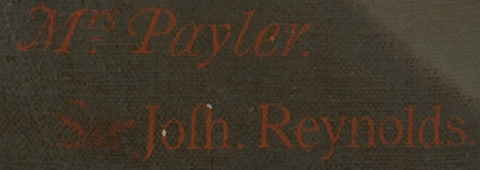
Back:
Item 2. Stamp on back of lower stretcher member: “R.C. Vose PAINTINGS BOSTON” (tech. fig. 2)
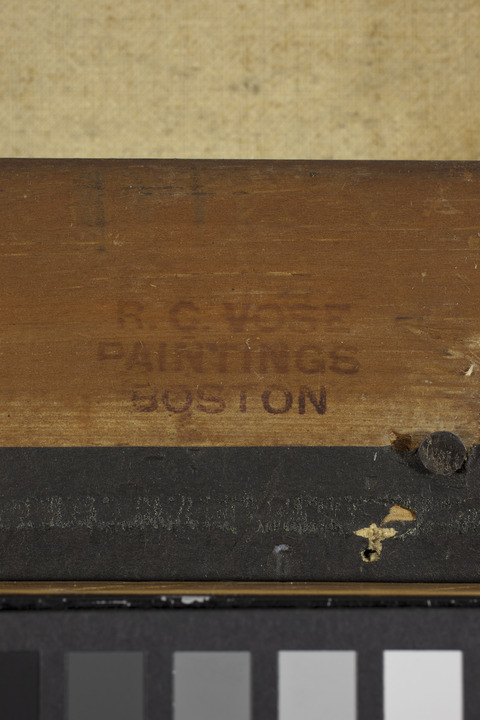
Item 3. Red-bordered label, back of top stretcher member: “3991/1” (tech. fig. 3).

Summary of Treatment History
Documentation suggests a series of condition assessments and treatments were carried out on the collection around the time the works were moved from the Clowes residence to the IMA in 1971. A condition report by Paul Spheeris in October of that year, likely carried out before the paintings were relocated, described the painting as needing cleaning for the sake of the work’s appearance but not for the stability of the paint layer. He also noted a chip on the frame but wrote that the painting is ok.1 A second condition assessment was carried out upon arrival of the paintings at the IMA. This assessment describes the work as in good condition and no work was deemed necessary beyond the inpainting of a small loss.2
In 1996, a memorandum summarizing treatment and examination of the Clowes Collection from the time it entered the collection suggests that no treatment was carried out on the painting up until this point.3 Physical evidence suggests that previous varnish removal and retouching, as well as lining, occurred prior to its arrival at the IMA, although no documentation of the treatment campaigns are recorded on file.
The painting was inspected in the Clowes Collection annual survey from 2011 to 2020.
Current Condition Summary
Structurally, the painting is in good condition. It has remained in a stable environment with very little shift in temperature and relative humidity and does not show signs of distress. Aesthetically, the painting is in fair condition, although the paint layer has been abraded with past cleaning interventions, the varnish has yellowed, and it is likely that some of the dye-based pigments have faded over time, causing the painting to appear less vibrant than when originally painted.
Methods of Examination, Imaging, and Analysis
| Examination/Imaging | Analysis (no sample required): | Analysis (sample required): |
|---|---|---|
| Unaided eye | Dendrochronology | Microchemical analysis |
| Optical microscopy | Wood identification | Fiber ID |
| Incident light | Microchemical analysis | Cross-section sampling |
| Raking light | Thread count analysis | Dispersed pigment sample |
| Reflected/specular light | X-ray fluorescence spectroscopy (XRF) | Fourier-transform infrared spectroscopy (FTIR) |
| Transmitted light | Macro X-ray fluorescence scanning (MA-XRF) | Raman microspectroscopy |
| Ultraviolet-induced visible fluorescence (UV) | ||
| Infrared reflectography (IRR) | Gas chromatography–mass spectrometry (GC-MS) | |
| Infrared transmittography (IRT) | Scanning electron microscope -energy dispersive X-ray spectroscopy (SEM-EDS) | |
| Infrared luminescence | Other: | |
| X-radiography |
Technical Examination
Description of Support
Analyzed Observed
Material (fabric, wood, metal, dendrochronology results, fiber ID information, etc.):
The painting is executed on a plain weave canvas. The thread count of the original canvas is 12 × 15 threads/cm (tech. fig. 4), while the lining canvas is 16 × 16 threads/cm.
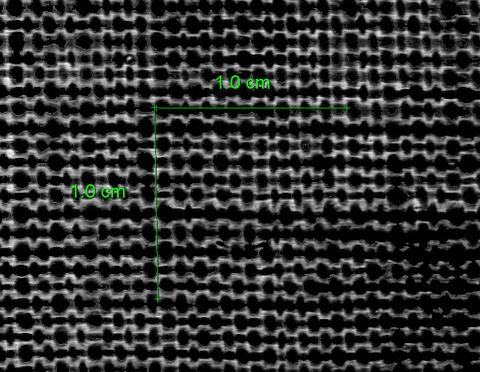
Characteristics of Construction / Fabrication (cusping, beveled edges of panels, seams, joins, battens):
Cusping and secondary cusping is present along all four edges, indicating that the painting remains the same dimensions as its original configuration (tech. fig. 5). These dimensions (approximately 30 × 25 in.) conform to the “bust or three-quarter” canvas size that was commercially available to artists in the eighteenth century.4 Standard picture sizes were frequently used by Reynolds and his studio.5 The canvas is evenly woven, although some incongruous threads are present. Most of the tacking margins are hidden beneath the black paper tape present along all four edges. In both the X-radiograph and in areas where the paper tape was removed or damaged, it is apparent that the original tacking margins were removed, likely when the painting was lined.
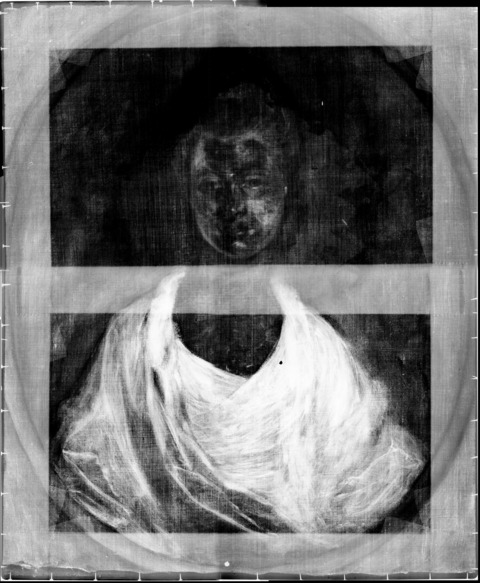
Thickness (for panels or boards):
N/A
Production/Dealer’s Marks:
none
Auxiliary Support:
Original Not original Not able to discern None
The auxiliary support is not original to the painting and consists of a five-member contemporary stretcher with mortise and tenon joints and a horizontal crossbar. The crossbar is set in from the canvas to prevent contact with the canvas. All ten keys are present. A stiff glue lining was applied to the back using a densely woven lining canvas.
Condition of Support
The canvas support is in good condition. There are a few losses around the canvas edges as well some minor holes. The adhesion between the support and the lining canvas remains strong with no visible signs of delamination. The stretcher is discolored with several nicks and dents from general wear over time but securely holds the painting. The support is in plane and adequately taut.
Description of Ground
Analyzed Observed
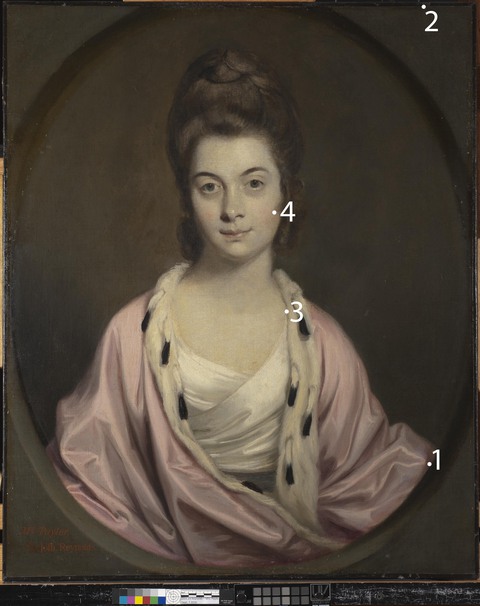
A thinly applied grayish-blue ground is present under areas of the woman’s shawl (cross section 1, tech. fig. 7) and the background (tech. fig. 9; see also cross section 2, tech. fig. 13). It appears as though Reynolds made use of a colored ground doubling as his background (see cross section 2, tech. fig. 13). In cross section 4-2, taken from the cheek, an off-white paint layer appears to be the initial layer (tech. fig. 8). The grayish-blue ground is not present at all in this area or elsewhere in the figure’s face and neck (tech. fig. 10). This suggests Reynolds deliberately applied a localized white ground to the area of flesh and the grayish-blue ground to the rest of the painting.
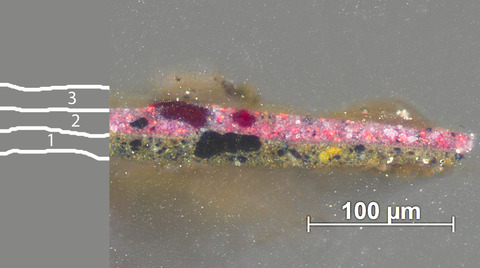
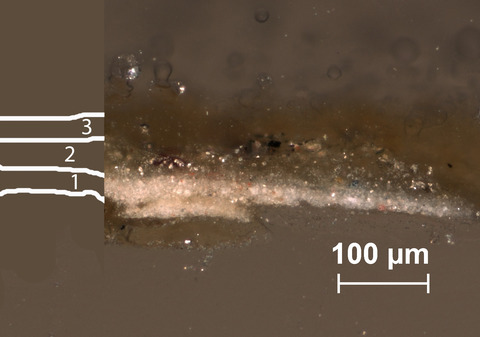
Localized application of white grounds in the faces of Reynolds’s portraits was noted by William Mason when describing Reynolds’s technique. Mason observed, “… on the light colored-canvas he had already laid a ground of white, where he meant to place the head, and which was still wet."6 According to Reynolds’s long-time assistant James Northcote, Reynolds “always painted on a bare cloth unprepared, after the manner of the Venetians."7 The Clowes painting may, in fact, be an example of this practice. However, Northcote’s statement has been contradicted by technical evidence that has found that Reynolds commonly used commercially prepared canvas, often with a double ground structure that was typical of eighteenth-century canvas prepared by English colormen.8 This indicates that, in the case of the Clowes painting, the composition was planned, and the ground was applied in such a way as to expedite the painting process, something Reynolds strove for in his practice.
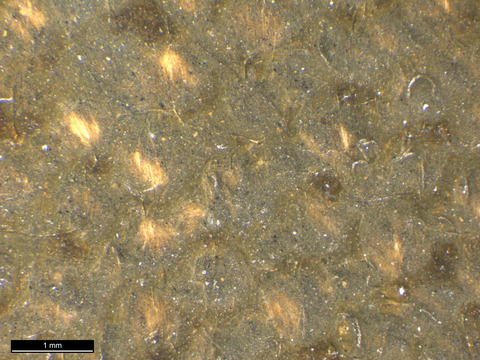
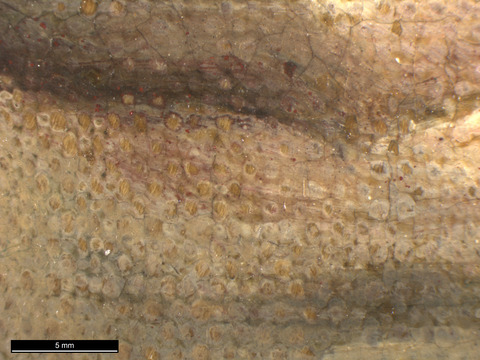
Materials/Binding Medium:
Appears to be oil, though analysis was not carried out
Color:
Grayish blue for background, off-white for underneath the face and neck
Application:
Likely brush applied
Thickness:
Relatively thin
Sizing:
A thin fluorescent layer is visible below the ground layer in the ultraviolet-induced visible fluorescence image of cross sections. This suggests a layer of size is present.
Character and Appearance (Does texture of support remain detectable / prominent?):
The texture of the canvas remains prominent through the ground and paint layers. Nubs of bare canvas are visible in several areas of the composition (tech. figs. 9, 10).
Condition of Ground
The ground layer is very thin, doubling as the paint layer in some areas of the background and skin, and exhibits a mechanical cracking network consistent with that of the painting’s natural aging process. The cracking network continues through to the paint layers. Severe abrasion to the paint layer and ground is present, likely from a previous cleaning intervention. In some cases, the ground is entirely abraded revealing nubs of raw canvas (tech. figs. 9, 10). The adhesion of the ground remains strong to both the canvas support and the paint layer.
Description of Composition Planning
Methods of Analysis:
Surface observation (unaided or with magnification)
Infrared reflectography (IRR)
X-radiography
Analysis Parameters:
| X-radiography equipment | GE Inspection Technologies Type: ERESCO 200MFR 3.1, Tube S/N: MIR 201E 58-2812, EN 12543: 1.0mm, Filter: 0.8mm Be + 2mm Al |
|---|---|
| KV: | 21 |
| mA: | 3 |
| Exposure time (s) | 120 |
| Distance from X-ray tube: | 36″ |
| IRR equipment and wavelength | Opus Instruments Osiris A1 infrared camera with InGaAs array detector operating at a wavelength of 0.9-1.7µm. |
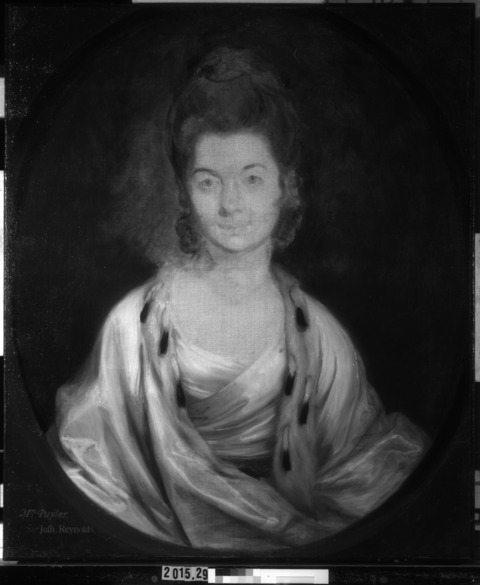
Medium/Technique:
There does not appear to be any underdrawing present in the painting (tech. fig. 11). Some dark outlines are present, for example in the hair; however, these lines are related to refinements of the painting technique rather than any deliberate underpainting and are also visible in normal lighting conditions. A lighter patch is visible along the sitter’s proper right beside her head, and it appears to be the rough painting in of the background, possibly where the white ground was applied to roughly mark out the space that would be used for the sitter. It is possible that other media were used, such as white or red chalk, which would not be visible in the reflected infrared image.
Pentimenti:
No pentimenti are visible. Minor adjustments and reinforcements are present in the hair and in the clothing folds along her proper left.
Description of Paint
Analyzed Observed
Application and Technique:
As discussed in Description of Ground, Reynolds appears to have applied a localized white ground to the area of the figure’s face and body directly over the raw canvas. This was likely in preparation for the painting during the sitting. At the early stage of painting, it seems that the background was left as raw canvas.
The face was rendered delicately, as is typical in many of his portraits. Over the five days of the figure’s sitting,9 Reynolds likely focused on the face and hair of the figure and probably sketched in the figure’s garments.10 The features of the face were painted quickly and efficiently using a subtle range of tones (tech. fig. 12). The shadows were articulated using warm purple and gray shadows, such as those found in the nostril and eyebrow, to create the deepest darks. Cool blue-green shadows, such as that on the side of the nose, were used to create midtone shadows. Glazes are not readily apparent in the painting of the skin and may have been abraded or removed during a previous cleaning. The cheeks were painted with a warm red paint that would have originally given the young woman a youthful glow. However, red lake pigments in the skin have almost certainly faded over time, resulting in a rather ghostly appearance. This is a well-documented issue in Reynolds’s paintings.11

Forms of the hair were established with a brown wash. Dark strands of hair were then painted to delineate shadows, and broad strokes of highlights were added on top.
Probably after the first few sittings, when the face had been established, the grayish-blue ground was applied to the background around the figure. The oval around the figure was then also painted. A brownish-yellow glaze was also applied over the grayish-blue background to modulate the tone (tech. fig. 13, layer 2). The yellow effect has been enhanced by the discolored yellow varnish.
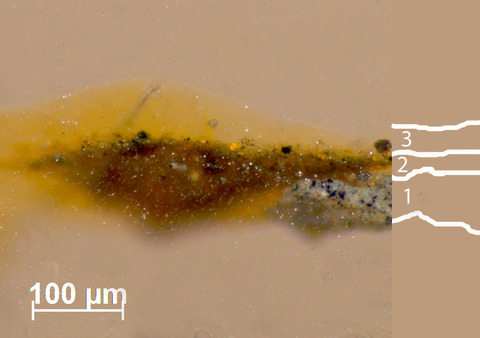
The paint in the garments were applied wet-in-wet (tech. fig. 14) with some impasto located in the folds of the fabric (white and pink areas) contrasting with the thinner applications of paint in the hair and face.
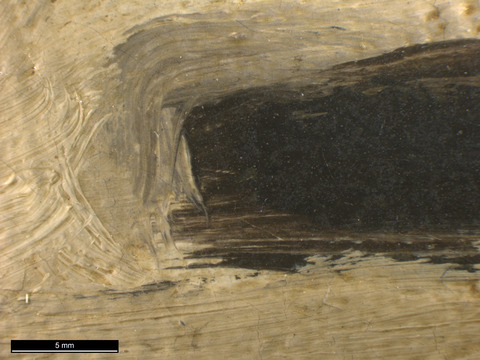
Painting Tools:
Brushes, primarily medium size
Binding Media:
Likely linseed oil, although more analysis is necessary as Reynolds’s technique could include unconventional and complex combinations of media including varnish, megilp, and driers.12 Reynolds was known for experimenting with pigments and various media, often adding driers to the paint to hasten the drying time.13
Color Palette:
The color palette is relatively simple with a green background, white and pink for the clothing and flesh tones, brown, and black. XRF analysis revealed the palette was primarily composed of lead white, iron-oxide (earth pigments), and vermilion, which are typical pigments used by Reynolds and many other artists during this time period. Organic pigments such as lakes, while not easily detected by XRF, were likely used in the pinks, skin tones, and garment, and would have been part of Reynolds’s palette.
Cross section 1 (tech. fig. 15) from the pink shawl shows red pigments that fluoresce bright red under ultraviolet irradiation, suggesting they may be madder lake (tech. fig. 16). A small amount of blue is present in the sitter’s eyes, though it is unclear if this is painted using the optical effects of scumbling white over black, or using a blue pigment such as Prussian blue or indigo, where XRF results would not yield any additional information (see table 1).
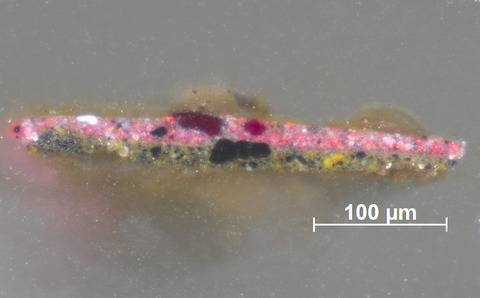
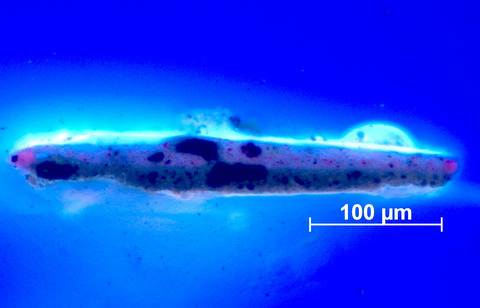
The artist’s signature and title of the painting are in bright red and are hidden by the oval frame (tech. fig. 1). XRF suggests that the inscription was painted using vermilion mixed with a chromium-containing pigment, likely chrome orange, yellow, or red. Chromium was detected in all areas of the signature, while no chromium was present in the underlying background paint. This suggests the inscription was added during or after the first quarter of the nineteenth century when chrome pigments were introduced.14
XRF Analysis:
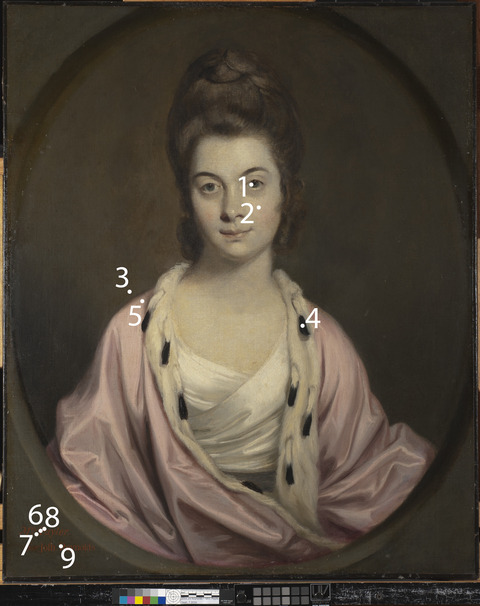
| Sample | Location | Elements | Possible Pigments |
|---|---|---|---|
| 1 | Proper left eye blue | Major: Pb Minor: Hg, Ca, Fe Trace: Cu, K, Mn, Ti, Zn | Lead white, vermilion, iron oxide (earth pigments including green earth), calcium (likely from ground layer), trace of copper-containing green pigment, trace of titanium (likely impurity from earth pigments), trace of manganese from umber pigment (or iron oxide impurity), trace of zinc (possibly from retouching or associated with the copper-containing pigment) |
| 2 | Skin tone proper left cheek | Major: Pb Minor: Ca, Hg Trace: Mn, Fe, Cu, K | Lead white, vermilion, trace of iron oxide (earth pigments including green earth), calcium (likely from ground layer), trace of copper-containing green pigment or azurite, trace of manganese from umber pigment (or iron oxide impurity). |
| 3 | Green background above proper right shoulder | Major: Pb, Fe, Ca Minor: Hg Trace: Mn, K, Zn, Ti, Cu | Lead white, iron oxide (earth pigments including green earth), calcium (likely from ground layer), vermilion, trace of copper-containing green pigment or azurite, trace of manganese from umber pigment (or iron oxide impurity). |
| 4 | Black in fur trim proper left uppermost black tail | Major: Pb, Ca, Fe Minor: P, Hg Trace: Mn, Cu, Ti, K | Bone black, lead white, calcium (from bone black and ground layer), iron oxide (earth pigments), vermilion, traces of umber, titanium white (overpaint or impurity), trace of copper-containing green pigment or azurite. |
| 5 | Pink in dress near left shoulder | Major: Pb Minor: Hg, Ca Trace: Fe, Mn | Lead white, vermilion, calcium (likely from ground layer), and traces of iron oxide (earth pigments). |
| 6 | “P” in red inscription bottom left | Major: Pb, Fe, Hg Minor: Ca, Cr Trace: Ba, Cu, K | Lead white; iron oxide (earth pigments including green earth); vermilion; chrome-containing red, yellow, and/or orange; traces of barium possibly as a filler; calcium (possibly from ground layer). |
| 7 | Green background behind “P” | Major: Pb Minor: Fe Trace: Ca | Lead white, iron oxide (earth pigments), calcium (possibly from ground layer). |
| 8 | Green background in center of “P” | Major: Pb Minor: Fe Trace: Ca | Lead white, iron oxide (earth pigments), calcium (possibly from ground layer). |
| 9 | “R” in red inscription bottom left | Major: Pb, Fe, Hg Minor: Ca, Cr Trace: | Lead white; iron oxide (earth pigments); vermilion; chrome-containing red, yellow, or orange; calcium (possibly from ground layer). |
Table 1: Results of X-ray fluorescence analysis conducted with a Bruker Artax microfocus XRF with rhodium tube, silicon-drift detector, and polycapillary focusing lens (~100μm spot).
*Major, minor, trace quantities are based on XRF signal strength not quantitative analysis.
Surface Appearance:
The surface exhibits some thick areas of impasto in the fabric but is otherwise very thin and flat. In part, this may be due to abrasion from previous restoration campaigns, but the painting also appears to have been deliberately painted thinly in some areas.
Condition of Paint
The paint is in stable condition. Some minor losses are present throughout, as well as extensive areas of abrasion in both the face and the background due to previous cleaning initiatives. A mechanical cracking pattern is present throughout the painting due to natural aging as well as the movement of the canvas in response to environmental moisture. The signature has been slightly abraded, as is visible in the “sir,” and possibly inpainted. The pinks and skin tones incorporated red lake pigments, as seen in the cross sections, which have faded over time and could be the reason for the sitter’s gray complexion. The oval painted around the sitter either has been trimmed at the upper edge and along both sides or was only roughly painted. It is difficult to tell as the brushwork is somewhat fragmented along the edges. A small part of the oval is missing due to trimming of the tacking margins and restretching on a new stretcher, but it is uncertain whether the oval was once complete.
Description of Varnish/Surface Coating
Analyzed Observed Documented
| Type of Varnish | Application |
|---|---|
| Natural resin | Spray applied |
| Synthetic resin/other | Brush applied |
| Multiple Layers observed | Undetermined |
| No coating detected |
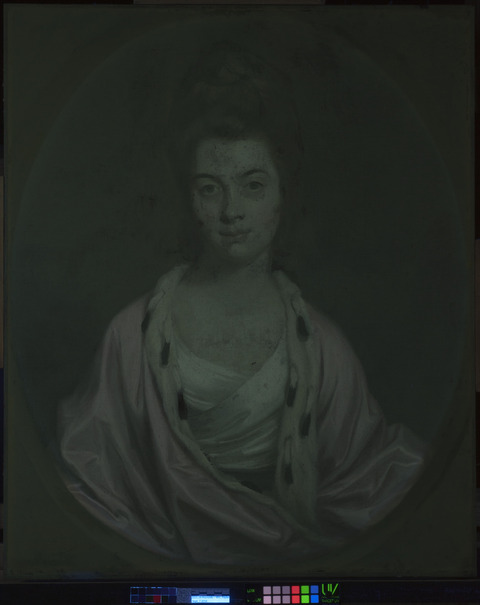
A natural resin varnish is present over the entire surface of the painting (tech. fig. 18). There is extensive retouching across the painting. Discolored retouching is visible in the face (tech. fig. 19) and additional retouching is present in many areas. Several layers of varnish are present along the outer area of the oval normally obscured by the frame. It is possible that these areas were not cleaned as often since they are not normally visible.
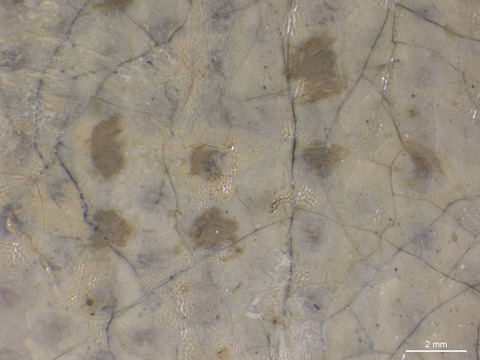
Condition of Varnish/Surface Coating
The varnish is in poor condition. The old, discolored varnish is pooled in the canvas interstices, contributing to the appearance of the canvas texture. Wear is present around the perimeter where the painting is in contact with the frame. The varnish has yellowed significantly over time due to the natural aging properties of the resin. The varnish is also unevenly applied, resulting in areas of high gloss and other areas of low gloss. The painting fits into a circular frame, and the paint layers under the framing edges are considerably more glossy. Small abrasions and scuffing are visible.
Description of Frame
Original/first frame
Period frame
Authenticity cannot be determined at this time/ further art historical research necessary
Reproduction frame (fabricated in the style of)
Replica frame (copy of an existing period frame)
Modern Frame
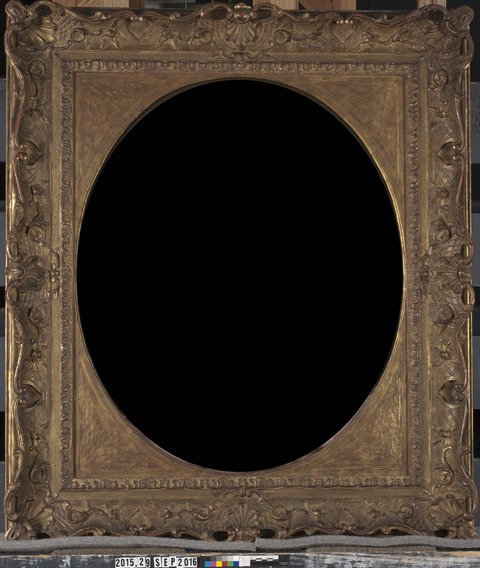
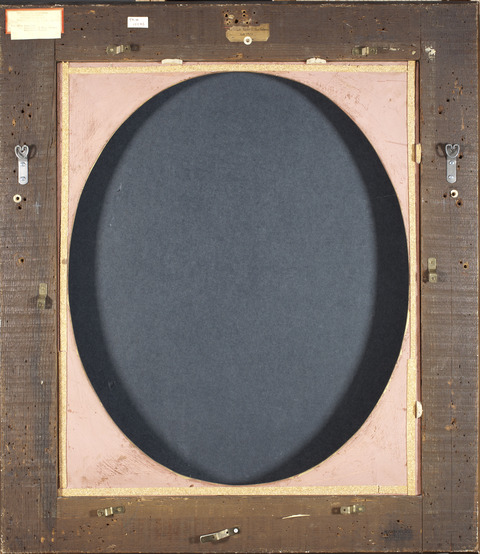
Frame Dimensions:
Outside frame dimensions: 98.5 × 86 cm
Sight size: 73.2 × 60.5 cm
Distinguishing Marks:
Item 4. Stamp, bottom member: “M. GRIEVE CO HAND CARVED NEW YORK & LONDON” (tech. fig. 22).

Item 5. Paper label with handwritten script, top member: “Lent Robert C. Vose Galleries/ 168.1930” (tech. fig. 23).
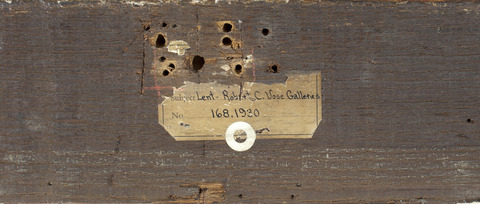
Item 6. Paper label with red border, upper left corner: “THE CLOWES FUND INCORPORATED/ FINE ARTS DEPARTMENT/ 3744 SPRING HOLLOW ROAD/ INDIANAPOLIS INDIANA U.S.A.” (tech. fig. 24).
Item 7. Paper label, upper left corner partially covering item 6: “No. 48 Reynolds/ Portrait of Mrs. Thomas/ Watkinson Payler” (tech. fig. 24).
Item 8. Paper label, upper-left side of top frame member: “TR # 10065” (tech. fig. 24).

Description of Molding/Profile:
As per frame specialist Timothy Newbery’s analysis,15 the frame is from about 1900, originating from New York (M Grieve + co), and is composed of carved oak with butted corners joined to back of frame (tech. fig. 25). Gilding is applied over a reddish-orange bole layer with decorative elements of acanthus leaves and husk. The frieze is composed of sand on cloth, and the cartouches incorporate anthemia and radiating checkered backgrounds. The frame is a version of a French pattern from about 1745. It has a distinct “beaten copper” appearance in the spandrel. The coppered spandrel was added as an adjustment to the frame.
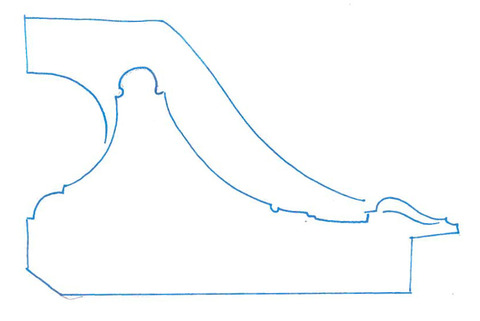
Condition of Frame
The frame is structurally sound and in good condition. Newbery suggests that the spandrel be reworked or possibly changed.
Notes
-
Paul A.J. Spheeris, “Conservation Report on the Condition of the Clowes Collection,” 25 October 1971, Conservation Department Files, Indianapolis Museum of Art at Newfields. ↩︎
-
Martin Radecki, Clowes Collection condition assessment, undated (after October 1971), Conservation Department Files, Indianapolis Museum of Art at Newfields. ↩︎
-
Memorandum from Martin Radecki to Bret Waller, “Conservation Work on Clowes Fund Collection,” 16 February 1996, Conservation Department Files, Indianapolis Museum of Art at Newfields. ↩︎
-
Alexandra Gent, “Reynolds, Paint and Painting: A Technical Analysis,” in Joshua Reynolds Experiments in Paint, ed. Lucy Davis and Mark Hallett (London: Trustees of the Wallace Collection, 2015), 51. ↩︎
-
Alexandra Gent, Ashok Roy, and Rachel Morrison, “Practice Makes Imperfect: Reynold’s Painting Technique,” in National Gallery Technical Bulletin 35 (2014): 14. ↩︎
-
William Mason, “Anecdotes of Sir Joshua Reynolds Chiefly Relative to His Manner of Coloring,” in Sir Joshua Reynolds' Notes and Observations on Pictures, Chiefly of the Venetian School, Being Extracts from His Italian Sketch Books; also, The Rev. W. Mason’s Observations on Sir Joshua’s Method of Coloring, and Some Unpublished Letters of Dr. Johnson, Malone, and Others, ed. William Cotton (London, J.R. Smith, 1859), 50–51. Other examples of this technique are noted in Alexandra Gent, Ashok Roy, and Rachel Morrison, “Practice Makes Imperfect: Reynold’s Painting Technique,” in National Gallery Technical Bulletin 35 (2014): 19–20. ↩︎
-
Northcote quoted in Alexandra Gent, Ashok Roy, and Rachel Morrison, “Practice Makes Imperfect: Reynold’s Painting Technique,” in National Gallery Technical Bulletin 35 (2014): 16. Original citation (as cited in Gent): James Northcote, letter dated 23 August 1771 (Royal Academy, NOR4). ↩︎
-
Alexandra Gent, Ashok Roy, and Rachel Morrison, “Practice Makes Imperfect: Reynold’s Painting Technique,” in National Gallery Technical Bulletin 35 (2014): 16–17. ↩︎
-
David Mannings and Martin Postle, Sir Joshua Reynolds: A Complete Catalogue of His Paintings (New Haven and London: Yale University Press, 2000), 1:369. ↩︎
-
For an example of an unfinished painting by Reynolds, see Portrait of a Man, probably Francis Barber (about 1770), 1983-103 DJ in the Menil Collection: https://www.menil.org/collection/objects/2829-portrait-of-a-man-probably-francis-barber ↩︎
-
Alexandra Gent, Ashok Roy, and Rachel Morrison, “Practice Makes Imperfect: Reynold’s Painting Technique,” in National Gallery Technical Bulletin 35 (2014): 27–28. ↩︎
-
Alexandra Gent, Ashok Roy, and Rachel Morrison, “Practice Makes Imperfect: Reynold’s Painting Technique,” in National Gallery Technical Bulletin 35 (2014): 25. ↩︎
-
Waldemar Januszczak, Techniques of the World’s Greatest Painters (Edison, NJ: Chartwell Books Inc., 1981), 66–69. ↩︎
-
Hermann Kuhn and Mary Curran, “Chrome Yellow and Other Chromate Pigments,” in Artists’ Pigments: A Handbook of Their History and Characteristics, ed. Robert L. Feller (New York: Oxford University Press, 1986), 1: 188. ↩︎
-
Timothy Newbery, frame specialist, London, England. Visual analysis completed at the Indianapolis Museum of Art, 19 January 2012. ↩︎
Additional Images
